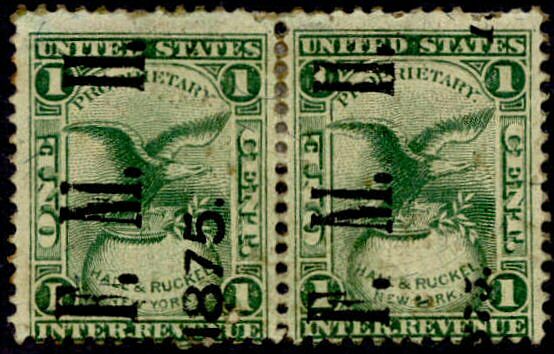

Hall & Ruckel


William Henry Hall and John H. Ruckel were friends with shops on Greenwich Street in New York. In the early 1850's they went into business together, and by 1863 they were manufacturing a dentifrice called Sozodont. In 1869 Hall and Leonard W. Warner acquired the business of L.R. Herrick (Herrick's Family Medicines), and other preparations like Dr. J.R. Stafford's Iron & Sulphur Powders and Stafford's Olive Tar. Later they developed or bought Lubin's Violette Tooth-Powder, Hall & Ruckel's Improved Seidlitz Powders and Walnut Leaf Hair Restorer.
Hall & Ruckel stamps were issued in two denominations. The one-cent was first issued in October, 1865, and last issued February 5, 1883. 2,373,112 were issued on old paper, 1,650,028 on silk paper and 2,835,592 on pink and watermarked papers. The one above is printed on watermarked paper.
The three-cent black stamps were issued first, in September of 1865, and last on the same day as the one-cent ones. 735,496 were issued on old paper, 388,145 on silk paper and 1,291,590 on pink and watermarked papers. The copy above is on silk paper.
Used copies were generally cancelled. The ones above may be remainders.

A trial color proof of the one-cent stamp.

An 1866 receipt from the Office of Hall & Ruckel.

In 1878 Hall & Ruckel became the sole marketing agents for X. Bazin's products: Toilet Soaps, Shaving Creams, Bandoline, Philocome Pomade, Toilet Waters, Cosmetics, Cologne, etc. Hall and Ruckel private die stamps were overprinted for use with these products.

A pair of Hall & Ruckel stamps with H.F.M. cancels, to be used on Herrick's Family Medicines products. Note that the date differs markedly in size between the left and right hand cancels.

A Hall & Ruckel merchant's draft from 1872.

A Hall & Ruckel cover from 1887.


Hall & Ruckel survived well into the Twentieth Century. The company did not use private die stamps during the Spanish American War tax era. These "battleship" revenues show Hall & Ruckel cancels.
Return